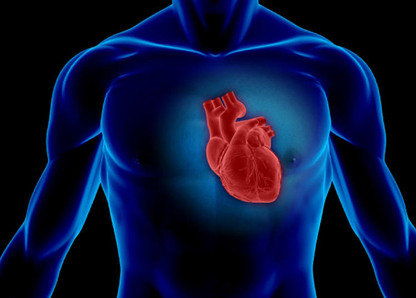So here-- I copied this from Wikipedia,
這個圖我是從維基百科中拿來的
this diagram of the human circulatory system-- and here in the back you can see the lungs.
顯示了人體的循環系統,后邊這里是肺
Let me do it in a nice dark color.
我用深色標一下
So we have our lungs here. Drew them right like that. Those are lungs.
這是肺部
You can see the heart is sitting right in the middle.
大家可以看到,心臟在中間
And what we learned in the last few videos is that we have our little alveoli and our lungs.
我們之前介紹過了,這里是肺部的肺泡
Remember, we get to them from our bronchioles,
它們連接了細支氣管
which are branching off of the bronchi, which branch off of the trachea,
細支氣管由支氣管分支形成,然后支氣管又由氣管分支形成
which connects to our larynx, which connects to our pharynx, which connects to our mouth and nose.
氣管連接咽喉,咽喉又到嘴和鼻子
But anyway, we have our little alveoli right there and then we have the capillaries.
這里是肺泡,這是毛細血管
So when we go away from the heart-- and we're going to delve a little bit into the heart in this video as well
遠離心臟的時候,我們待會也會介紹一下心臟
so when blood travels away from the heart, it's de-oxygenated.
血液遠離心臟時,是缺氧血
It's this blue color. So this right here is blood.
缺氧血用藍色表示
This right here is blood traveling away from the heart.
這是遠離心臟的血液

It's going behind these two tubes right there.
從這兩條血管走
So this is the blood going away from the heart.
這是遠離心臟的血液
So this blue that I've been highlighting just now, these are the pulmonary arteries
剛用藍色標注的,這是肺動脈
and then they keep splitting into arterials and all of that and eventually we're in capillaries-- super, super small tubes.
之后分成一系列動脈,最后來到毛細血管,也就是非常非常細的血管
They run right past the alveoli and then they become oxygenated and now we're going back to the heart.
通過肺泡,血液補充了氧氣,再回到心臟
So we're talking about pulmonary veins.
通過肺靜脈
So we go back to the heart.
回到心臟
So these capillaries-- in the capillaries we get oxygen.
在這里的毛細血管,血液補充了氧氣
Now we're going to go back to the heart.
然后回到心臟
Hope you can see what I'm doing.
希望大家能看清楚我標注的
And we're going to enter the heart on this side.
血液從這里回到心臟
You actually can't even see where we're entering the heart.
實際上大家應該看不到進入心臟的位置
We're going to enter the heart right over here-- and I'm going to go into more detail on that.
我們從這里進入心臟,之后我們再詳細介紹
Now we have oxygenated blood. It's red.
現在血液是含氧血,用紅色標注
And then that gets pumped out to the rest of the body.
然后被運送到身體各處
Now this is the interesting thing.
這是有意思的地方
When we're talking about pulmonary arteries and veins-- remember, the pulmonary artery was blue.
因為剛我們說到了肺動脈和肺靜脈,注意,肺動脈是藍色的
As we go away from the heart, we have de-oxygenated blood, but it's still an artery.
離開心臟的時候,是缺氧血,卻是在動脈里
Then as we go towards the heart from the lungs,
然后從肺部回到心臟的血液
we have a vein, but it's oxygenated. Let me write that down.
是含氧血,通過靜脈運送的,我寫一下
I wrote that in the last video. But pulmonary- so the pulmonary artery, no oxygen.
上集我們也介紹過,肺動脈輸送的沒有氧氣
Or maybe i shouldn't write that. I should write deoxygenated.
應該說是缺氧血
Because there might be some oxygen. Deoxygenated.
因為可能還是有一點氧氣的
And then the pulmonary vein, it has oxygen.
而肺靜脈中的血液,是含有氧氣的
So that's this little loop here that we start and I'm going to keep going over the circulation pattern
這就形成了一個循環,我盡量介紹清楚循環的模式
because the heart can get a little confusing,
因為這是三維圖
especially because of its three-dimensional nature.
在心臟的部分,可能會容易混淆











